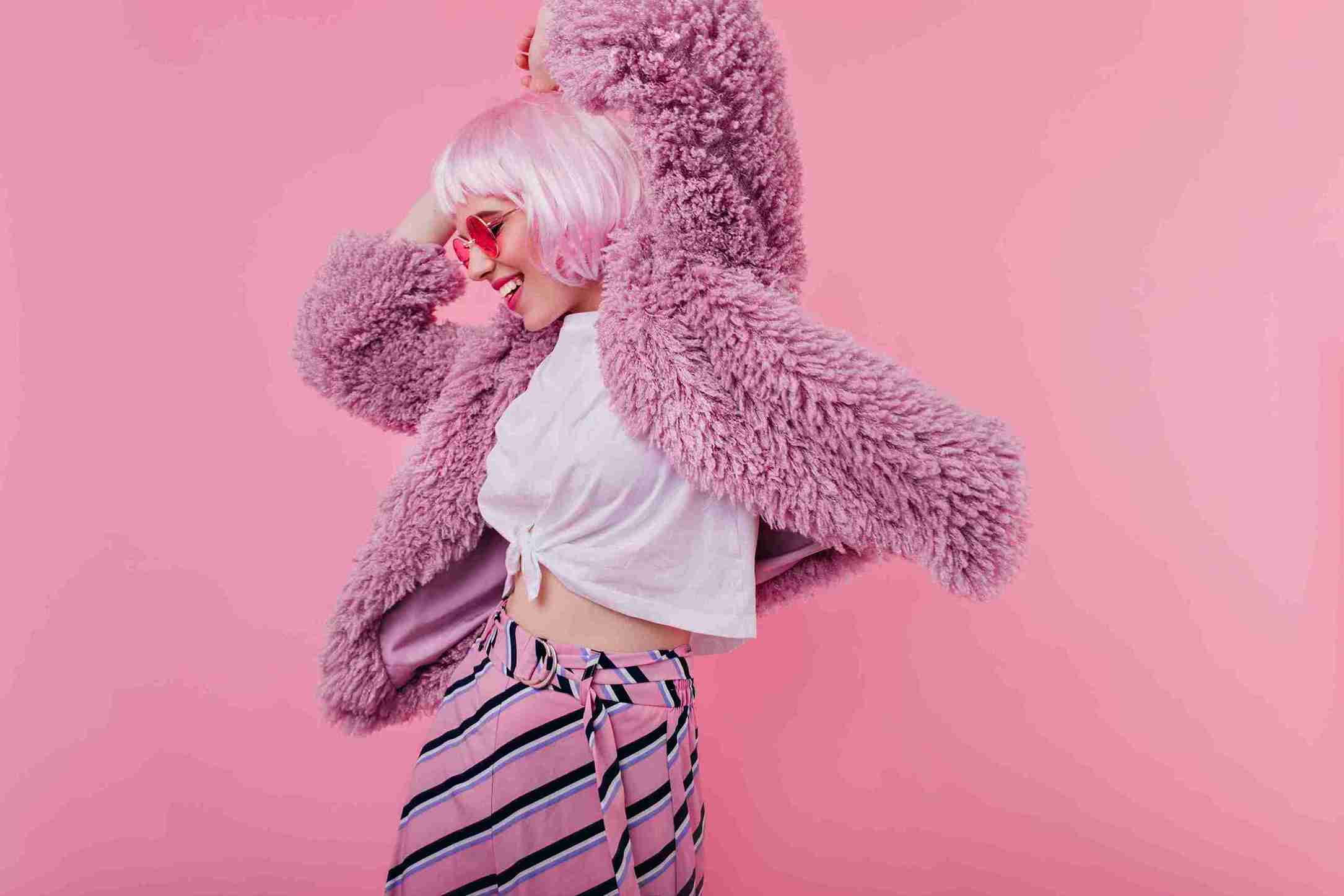Harajuku fashion is more than just a style—it celebrates individuality and self-expression that has captivated the world for decades. Originating in the Harajuku district of Tokyo, Japan, this fashion movement has evolved into a global phenomenon, blending tradition with modern influences. Harajuku fashion is unique because of its fearless embrace of creativity, color, and personal style. Whether it’s the Lolita-inspired elegance or the punk-rock edge of Visual Kei, Harajuku fashion represents an eclectic mix that dares to break the rules.
The Origins of Harajuku Fashion
The roots of Harajuku fashion can be traced back to the 1980s when Tokyo’s Harajuku district became a hub for young people seeking to express their identities through fashion. Over time, the area became known for its street fashion, drawing international attention. The blending of various subcultures—ranging from goth and punk to kawaii and high fashion—allowed the district to develop a unique style that would later be dubbed “Harajuku fashion.” The explosion of creativity in this district led to the creation of iconic fashion styles that have influenced designers worldwide.
Key Styles in Harajuku Fashion
Harajuku fashion is a melting pot of many distinct subcultures, each contributing to today’s rich diversity. Lolita fashion is one of the most iconic styles, drawing inspiration from the Victorian and Rococo eras. Known for its intricate lace, frills, and modest designs, Lolita fashion embodies a refined yet playful aesthetic. Another popular style is Gyaru, which emphasizes bold makeup, dramatic hairstyles, and a glamorous, trendy look. The combination of tanned skin, platform shoes, and flashy clothing reflects confidence and rebellion against traditional Japanese beauty standards.
Decora: The Playful Side of Harajuku
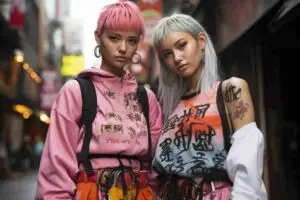
Decora is another popular style that showcases Harajuku’s playful, colorful side. Bright hues, layered accessories, and a youthful attitude define this aesthetic. The key elements of Decora fashion include an overload of colorful hair clips, beads, and necklaces, creating a vibrant, whimsical look. The style reflects the carefree spirit of youth and is often associated with a sense of joy and fun. Decora’s bold and quirky nature starkly contrasts more reserved and traditional Japanese fashion, making it a standout within Harajuku’s diverse fashion scene.
Visual Kei: Fashion Meets Rock ‘n’ Roll
One of the more dramatic styles in Harajuku fashion is Visual Kei—a look inspired by Japanese rock bands that combine androgynous fashion with theatrical elements. Visual Kei is known for its dark, edgy vibe, featuring long, wild hair, heavy makeup, and oversized clothing. The fashion is often elaborate and theatrical, designed to make a statement on and off stage. This style is deeply connected to music culture, with many Visual Kei enthusiasts taking inspiration from their favorite bands. Over time, the aesthetic has become a symbol of personal freedom and rebellious self-expression.
Kawaii: The Cutest Fashion Trend
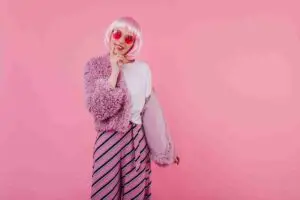
If one thing defines Harajuku fashion, it’s the concept of Kawaii, or “cute.“ Kawaii fashion emphasizes pastel colors, oversized sweaters, bows, and accessories. The look is often childlike, bringing together elements of innocence and playfulness. Popularized by figures like Hello Kitty and other cute icons, Kawaii fashion has become a global trend. It reflects that fashion doesn’t have to be serious or sophisticated to be impactful—it can be fun, whimsical, and heartwarming.
Harajuku Fashion and Global Influence
While Harajuku fashion started as a localized trend, it has since transcended Japan’s borders to become a worldwide phenomenon. Fashion designers from all over the globe have drawn inspiration from Harajuku’s diverse and often unexpected pairings. Major fashion houses like Comme des Garçons and Issey Miyake have incorporated elements of Harajuku style into their collections. The street fashion of Harajuku has also influenced international fashion trends, with designers embracing vibrant colors, oversized silhouettes, and an array of textures. Harajuku fashion, in essence, has become a symbol of global youth culture, inspiring a new wave of individuality and personal expression.
Harajuku Fashion: A Symbol of Youth Identity
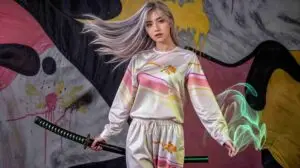
At its core, Harajuku fashion reflects youth culture, where the boundaries between personal style and societal norms are blurred. For many young people, dressing in Harajuku style is a way to stand out, express themselves, and make a statement about who they are. The fashion scene in Harajuku is a direct response to the pressures of conformity, allowing individuals to challenge traditional expectations of beauty and fashion. It is about embracing differences, celebrating creativity, and defining one’s identity in a world that often promotes uniformity.
The Future of Harajuku Fashion
As Harajuku fashion continues to evolve, it’s clear that its influence is here to stay. Young people worldwide continue to draw inspiration from the colorful, eclectic styles that emerged from the Harajuku district. Today, social media platforms like Instagram and TikTok have allowed Harajuku fashion to reach new audiences, particularly younger generations eager to showcase their unique looks. Whether through DIY fashion, thrifting, or collaborations with global brands, Harajuku fashion is adapting to the digital age while staying true to its roots of self-expression and creativity.
Why Harajuku Fashion Matters
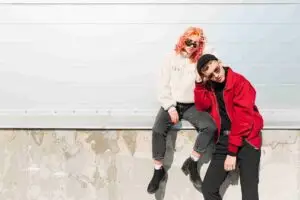
Harajuku fashion is more than just clothing—it’s a cultural movement that celebrates diversity, individuality, and freedom of expression. Breaking away from traditional fashion norms allows people to define their style and showcase their personality uniquely. In a world where fast fashion and mass trends dominate, Harajuku fashion remains a refreshing reminder that style is a personal journey, not a dictated standard. Whether you’re drawn to its vibrant colors, intricate layers, or whimsical accessories, Harajuku fashion is a constant source of inspiration for anyone looking to make a bold fashion statement.
FAQs About Harajuku Fashion
Q: What is Harajuku fashion?
Ans: Harajuku fashion refers to the unique and eclectic style in the Harajuku district of Tokyo, Japan. It is characterized by bold combinations of colors, patterns, and subcultures, often blending elements like punk, goth, kawaii, and streetwear. The style embraces individuality and self-expression with fashion-forward outfits that frequently defy traditional trends.
Q: What are the different types of Harajuku fashion?
Ans: Harajuku fashion includes various distinct styles, such as:
- Lolita: Inspired by Victorian and Rococo clothing, featuring frilly dresses and modest designs.
- Gyaru: A glamorous style focusing on dramatic makeup, tanned skin, and trendy clothing.
- Visual Kei: A rock-inspired fashion with androgynous looks, heavy makeup, and dramatic hairstyles.
- Decora: Known for vibrant colors, layers of accessories, and a playful, youthful vibe.
- Kawaii: Cute and childlike, incorporating pastel colors, oversized sweaters, and bows.
Q: Why is Harajuku fashion so popular?
Ans: Harajuku fashion became popular because it breaks traditional rules and celebrates personal style and creativity. It’s a rebellion against mainstream fashion, offering a space where anyone can wear what they want without fear of judgment. This freedom of expression has made it particularly appealing to young people worldwide.
{
“@context”: “https://schema.org”,
“@type”: “FAQPage”,
“mainEntity”: [{
“@type”: “Question”,
“name”: “Q: What is Harajuku fashion?”,
“acceptedAnswer”: {
“@type”: “Answer”,
“text”: “Ans: Harajuku fashion refers to the unique and eclectic style in the Harajuku district of Tokyo, Japan. It is characterized by bold combinations of colors, patterns, and subcultures, often blending elements like punk, goth, kawaii, and streetwear. The style embraces individuality and self-expression with fashion-forward outfits that frequently defy traditional trends.”
}
},{
“@type”: “Question”,
“name”: “Q: What are the different types of Harajuku fashion?”,
“acceptedAnswer”: {
“@type”: “Answer”,
“text”: “Ans: Harajuku fashion includes various distinct styles, such as:
Lolita: Inspired by Victorian and Rococo clothing, featuring frilly dresses and modest designs.
Gyaru: A glamorous style focusing on dramatic makeup, tanned skin, and trendy clothing.
Visual Kei: A rock-inspired fashion with androgynous looks, heavy makeup, and dramatic hairstyles.
Decora: Known for vibrant colors, layers of accessories, and a playful, youthful vibe.
Kawaii: Cute and childlike, incorporating pastel colors, oversized sweaters, and bows.”
}
},{
“@type”: “Question”,
“name”: “Q: Why is Harajuku fashion so popular?”,
“acceptedAnswer”: {
“@type”: “Answer”,
“text”: “Ans: Harajuku fashion became popular because it breaks traditional rules and celebrates personal style and creativity. It’s a rebellion against mainstream fashion, offering a space where anyone can wear what they want without fear of judgment. This freedom of expression has made it particularly appealing to young people worldwide.”
}
}]
}

